| View previous topic :: View next topic |
| Author |
Message |
cooltouch


Joined: 15 Jan 2009
Posts: 9097
Location: Houston, Texas
|
 Posted: Tue May 03, 2011 5:05 am Post subject: Teleconverter Comparison: Tamron 01F vs. Vivitar Macro Posted: Tue May 03, 2011 5:05 am Post subject: Teleconverter Comparison: Tamron 01F vs. Vivitar Macro |
 |
|
cooltouch wrote:
This is in response to the thread running currently that is asking the question, "What is the best quality 2x teleconverter?" I offered to test both a Tamron 01F 2x and a Vivitar 2x Macro TC. The following images are some of the ones I shot for this test. The lens used was a Tamron SP 90mm f/2.5 macro.
The subject is a 50 NT$ bill. This is Taiwanese currency, and NT$ stands for New Taiwan Dollar, most widely spoken of as "NT". Here's a quick shot of the entire note:

This is the full image that the Tamron without teleconverters sees.

I took photos at f/2.5, f/4, f/5.6, f/8, and f/11. Honestly, I couldn't see much difference between the various aperture settings. So for this test, I selected f/2.5, f/5.6, and f/11. If you would like to see images at one of the other aperture values, let me know and I can display them for you.
You will notice some coloration differences between the various selections. I wouldn't put too much emphasis on this. I took the photos using a household incandescent lamp for illumination, then color-corrected them in Canon's DPP software. So, some of the color corrections may be a bit different from each other.
For the test, I focused on the subject's left eye. The images show a 100% crop of the image taken with a Tamron 90mm macro, and images taken with the Tamron and a 01F Tamron 2x TC and a Vivitar macro 2x TC, which were reduced to the same size as the images taken with the Tamron 90mm macro alone. The amount of reduction was approximately 50%.
At f/2.5 indicated

At f/5.6 indicated

At f/11 indicated

I'd be lying if I told you I saw any significant difference between any of these exposures. Well, except maybe at f/2.5, where the Tamron without TCs was a bit soft, but was clearly sharper with either TC. So go figure that one out. Yes, I can notice some very slight differences with some of the exposures. But are they enough to matter, I ask myself. And I just don't think they are.
Stay tuned. For my next comparison, I will do just the reverse. This next one will have the TC images at 100% and I will upsize the images without TCs to the same size. This test will indicate if the TCs provide any additional resolution.
_________________
Michael
My Gear List: http://michaelmcbroom.com/photo/gear.html
My Gallery: http://michaelmcbroom.com/gallery3/index.php/
My Flickr Page: https://www.flickr.com/photos/11308754@N08/albums
My Music: https://soundcloud.com/michaelmcbroom/albums
My Blog: http://michaelmcbroom.com/blogistan/
Last edited by cooltouch on Tue Sep 10, 2013 4:40 pm; edited 1 time in total |
|
| Back to top |
|
 |
my_photography

Joined: 03 Nov 2008
Posts: 2772
Location: Pearl of the Orient
Expire: 2016-12-25
|
 Posted: Tue May 03, 2011 5:37 am Post subject: Posted: Tue May 03, 2011 5:37 am Post subject: |
 |
|
my_photography wrote:
Since reading the other thread, I was waiting for your test. Interesting result. I too don't see any significant lost in detail in your "shrinking down" approach.
Perhaps by reducing the photos with the converters by 50%, the lost are also being compressed therefore we don't see any significant change.
_________________
Zeiss: CJZ Flektogon 20/2.8, CJZ Flektogon 20/4, , CJZ Pentacon 29/2.8, CJZ Flektogon 35/2.4, CJZ Pancolar 50/1.8, Tessar 50/2.8, Biotar 7.5cm/1.5, CJZ Pancolar 80/1.8, CJZ Sonnar 135/3.5, CJZ Pentacon 135/2.8 CJZ Sonnar 200/2.8
Other Germany: Meyer Primoplan 50/1.8, Meyer Trioplan 100/2.8
Takumar: SMC 50/1.4 Super Tak 55/2, Super Tak 85/1.9, S-M-C 135/3.5, Super Tak 150/4
Russian: Zenith 16/2.8, Mir-24M 2/35, Volna-9 50/2.8, Helios 44M (58/2), Helios 44M-3 MC (58/2), Helios 40 (85/1.5), Tair 11A (135/2.8 )
Others: Sears 28/2.8, Sankor 35/2.8, Enna M�nchen Tele-Ennalyt 135/3.5
Zoom Sigma Zoom 28-85/3.5-4.5
|
|
| Back to top |
|
 |
DSG


Joined: 04 Mar 2007
Posts: 544
Location: London, UK.
|
 Posted: Tue May 03, 2011 11:44 am Post subject: Posted: Tue May 03, 2011 11:44 am Post subject: |
 |
|
DSG wrote:
| my_photography wrote: |
Since reading the other thread, I was waiting for your test. Interesting result. I too don't see any significant lost in detail in your "shrinking down" approach.
Perhaps by reducing the photos with the converters by 50%, the lost are also being compressed therefore we don't see any significant change. |
The 01F looks sharper than the Vivitar to me, especially in the f11 samples.
But I was hoping to see some outdoor shots with high contrast transitions so we could see how much CA they produce...That would be much more usefull to me as I know the 01F is pretty good in this area. |
|
| Back to top |
|
 |
estudleon


Joined: 15 May 2008
Posts: 3754
Location: Argentina
|
 Posted: Tue May 03, 2011 2:13 pm Post subject: Posted: Tue May 03, 2011 2:13 pm Post subject: |
 |
|
estudleon wrote:
Thanks for sharing.
This excelent test complete to the older made about others teleconverters, in which the russian one won.
Rino.
_________________
Konica 2,8/100
CZJ: 4/20, 2,4/35, 1,8/50 aus jena, 3,5/135MC, Pentacon 1,8/50
Pentax S-M-C-1,4/50
Helios 44-3
Mamiya 2,8/135
Misc. : jupiter 9
Stuff used:
A) SRL
Alpa 10 D - kern macro Switar 1,9/50 -black, Kilffit apochromat 2/100.
Asahi pentax spotmatic super takumar 1,4/50
Contaflex super B tessar 2,8/50 Pro-tessar 115
Leica R3 electronic summicron 2/50 elmarit 2,8/35
Konica Autoreflex 3 (2 black and chrome one), TC, T4. 2,8/24, 3,5/28 not MC and MC, 1,8/40, 1,4/50, 1,7/50 MC and not MC, 1,8/85, 3,2/135, 3,5/135, 4/200
Minolta XG9 2,8/35, 2/45, 3,5/135
Nikkormat FTn 1,4/50, 2,8/135
Fujica ST 801, 605, 705n. 3,5/19, 1,4/50, 1,8/55, 4/85, 3,5/135.
Praktica MTL 5 and a lot of M42 lenses.
Voigtlander. Bessamatic m, bessamatix de luxe, bessamatic cs, ultramatic and ultramatic cs.
Skoparex 3,5/35, skopagon 2/40, skopar 2,8/50, skopar X 2,8/50, super lanthar (out of catalogue) 2,8/50, dinarex 3,4/90, dinarex 4,8/100, super dinarex 4/135, super dinarex 4/200, zoomar 2,8/36-83, portrait lens 0, 1 and 2. Curtagon 4/28 and 2,8/35
Canon AV1, 1,8/50
Rolleiflex SL35 and SL35 E. 2,8/35 angulon, 2,8/35 distagon, 1,4/55 rolleinar, 1,8/50 planar, 4/135 tessar, 2,8/135 rolleinar, x2 rollei, M42 to rollei adap.
Etc.
RF
Yashica Minister III
Voightlander Vito, vitomatic I, Vito C, etc.
Leica M. M2, M3 (d.s.) and M4. Schenider 3,4/21, 2/35 summaron 2,8/35 (with eyes). Summicron 2/35 (8 elements with eyes), 2/35 chrome, 2/35 black, 1,4/35 pre asph and aspheric - old -, 2/40 summicron, 2,8/50 elmar, 2/50 7 elements, 2/50 DR, 2/50 - minolta version, 1,4/50 summilux 1966 version, 1,4/75 summilux, 2/90 large version, 2/90 reduced version of 1987, 2,8/90 elmarit large version, 4/135 elmar. |
|
| Back to top |
|
 |
cooltouch


Joined: 15 Jan 2009
Posts: 9097
Location: Houston, Texas
|
 Posted: Tue May 03, 2011 2:46 pm Post subject: Posted: Tue May 03, 2011 2:46 pm Post subject: |
 |
|
cooltouch wrote:
| DSG wrote: |
| my_photography wrote: |
Since reading the other thread, I was waiting for your test. Interesting result. I too don't see any significant lost in detail in your "shrinking down" approach.
Perhaps by reducing the photos with the converters by 50%, the lost are also being compressed therefore we don't see any significant change. |
The 01F looks sharper than the Vivitar to me, especially in the f11 samples.
But I was hoping to see some outdoor shots with high contrast transitions so we could see how much CA they produce...That would be much more usefull to me as I know the 01F is pretty good in this area. |
I honestly don't see any difference in sharpness except at f/2.5 where the images with the TCs are sharper than the image without. But it could be the subject I chose, too. At least it shows that both TCs perform well in close-up photography.
Yours is a good suggestion, though. It's overcast this morning but if the sun breaks through the clouds later, I can set up the camera and a telephoto lens to shoot at my favorite telephoto test subject -- a water kiosk about 400 meters down the street from me. It has trim objects that will produce CA on a sunny day.
I've been working on another comparison, this one where the TCs are at 100% and the images without are upsized. This one is also a close-up shot. Taken outdoors, but not enough high contrast areas to produce noticeable CA.
_________________
Michael
My Gear List: http://michaelmcbroom.com/photo/gear.html
My Gallery: http://michaelmcbroom.com/gallery3/index.php/
My Flickr Page: https://www.flickr.com/photos/11308754@N08/albums
My Music: https://soundcloud.com/michaelmcbroom/albums
My Blog: http://michaelmcbroom.com/blogistan/
Last edited by cooltouch on Sat Feb 23, 2013 11:28 pm; edited 1 time in total |
|
| Back to top |
|
 |
cooltouch


Joined: 15 Jan 2009
Posts: 9097
Location: Houston, Texas
|
 Posted: Tue May 03, 2011 6:46 pm Post subject: Posted: Tue May 03, 2011 6:46 pm Post subject: |
 |
|
cooltouch wrote:
Okay here is the test I mentioned in my last post. The subject is a small plant growing next to a brick that is inset into the soil. For the tests, I focused on the small yellow flower bud.
Tamron 90mm macro at f/8, ISO 100

The object to this test is to determine if the TCs capture additional information. I stated previously that I believed they did not. Well, we'll see.
One point I should make: The apertures I mention below are indicated apertures. Of course, when a 2x is used, one loses two stops of light. But because I'm comparing a lens without a TC to the same lens with TCs, I'm just trying to keep the notation simple. Plus, I am attempting to show the differences in depth of field that each aperture value has, and aperture opening determines this, not the reduction in light caused by the use of a TC. You the reader will have to bear in mind that the images taken with the TCs have effectively lost two stops of light.
Subject with the Lens wide open, ISO 100

With the lens aperture set to f/5.6

There is some motion-induced blur of the leaf, but not the flower, in the Tamron 01F image. Not a lot, but enough to cause it to look less sharp than the Vivitar's. I thought about substituting the f/4 or f/8 image but they were worse. And I just didn't feel like going out there and reshooting the scene for one image. Oh well.
With the lens aperture set to f/11

Another thing I should mention about the above test. I had to reshoot the images taken with the Vivitar TC because I had too much motion-caused blur in the photos. It was windy when I was taking these shots. When I went back to reshoot the subject using the Vivitar, the lighting had changed from bright sun to a mild overcast. This eliminated hard shadows, and also eliminated reflections of the sunlight from the leaves of this plant. Reflections are noticeable in the shots with the lens with no TCs and with the Tamron TC. But there are no reflections with the Vivitar. So, when you're examining these photos, you need to keep that in mind. I say this because it might appear that the Tamron 01F is doing a better job than the Vivitar when all that it really is is that the Tamron has recorded reflections that weren't there for the Vivitar's tests.
Conclusion: It would appear that at wider open apertures (say, from f/2.5 to f/5.6), the teleconverters are capable of recording more detail than the lens alone. But by f/11, there doesn't really appear to be an appreciable difference. To my eyes, the Tamron 01F appears to slightly outperform the Vivitar, and in terms of detail appears to be a very close match to the upsized image taken with no TC. I also notice that the Vivitar seems to be having trouble with bright yellow. There is a noticeable lack of detail in the flower in all three images, and it appear that there is a bit of blooming flare as well. As I mentioned at the beginning, the small yellow flower bud was my point of focus. Whether through the viewfinder or using Live View, this lack of detail and/or bit of flare was not evident.
I still plan on conducting at least one more test. This one will be of a high-contrast subject and background to determine what sort of CA is evident, if any.
So, what do y'all think?
_________________
Michael
My Gear List: http://michaelmcbroom.com/photo/gear.html
My Gallery: http://michaelmcbroom.com/gallery3/index.php/
My Flickr Page: https://www.flickr.com/photos/11308754@N08/albums
My Music: https://soundcloud.com/michaelmcbroom/albums
My Blog: http://michaelmcbroom.com/blogistan/
Last edited by cooltouch on Sat Feb 23, 2013 11:29 pm; edited 1 time in total |
|
| Back to top |
|
 |
DSG


Joined: 04 Mar 2007
Posts: 544
Location: London, UK.
|
 Posted: Tue May 03, 2011 10:13 pm Post subject: Posted: Tue May 03, 2011 10:13 pm Post subject: |
 |
|
DSG wrote:
| cooltouch wrote: |
Okay here is the test I mentioned in my last post. The subject is a small plant growing next to a brick that is inset into the soil. For the tests, I focused on the small yellow flower bud.
Tamron 90mm macro at f/8, ISO 100

The object to this test is to determine if the TCs capture additional information. I stated previously that I believed they did not. Well, we'll see.
As I mentioned above, I realized that these two teleconverters have different magnifications. The Vivitar is a 2x. The Tamron, as it turns out, is a 2.67x. That's a noticeable difference in magnification. So, because of this, I used the Vivitar's magnification as the yardstick, and reduced the Tamron's image size to that of the Vivitars, and increased the Tamron 90mm's image size to that of the Vivitar's. It matters what sort of routine one uses for changing image sizes. I have always found that "bicubic" works the best, so that's what I used when I changed image sizes for this test. No other PP of any kind was done to any of the images in this test. That goes for the images above in the previous test, also.
One point I should make: The apertures I mention below are indicated apertures. Of course, when a 2x is used, one loses two stops of light. But because I'm comparing a lens without a TC to the same lens with TCs, I'm just trying to keep the notation simple. Plus, I am attempting to show the differences in depth of field that each aperture value has, and aperture opening determines this, not the reduction in light caused by the use of a TC. You the reader will have to bear in mind that the images taken with the TCs have effectively lost two stops of light.
Subject with the Lens wide open, ISO 100

With the lens aperture set to f/5.6

There is some motion-induced blur of the leaf, but not the flower, in the Tamron 01F image. Not a lot, but enough to cause it to look less sharp than the Vivitar's. I thought about substituting the f/4 or f/8 image but they were worse. And I just didn't feel like going out there and reshooting the scene for one image. Oh well.
With the lens aperture set to f/11

Another thing I should mention about the above test. I had to reshoot the images taken with the Vivitar TC because I had too much motion-caused blur in the photos. It was windy when I was taking these shots. When I went back to reshoot the subject using the Vivitar, the lighting had changed from bright sun to a mild overcast. This eliminated hard shadows, and also eliminated reflections of the sunlight from the leaves of this plant. Reflections are noticeable in the shots with the lens with no TCs and with the Tamron TC. But there are no reflections with the Vivitar. So, when you're examining these photos, you need to keep that in mind. I say this because it might appear that the Tamron 01F is doing a better job than the Vivitar when all that it really is is that the Tamron has recorded reflections that weren't there for the Vivitar's tests.
Conclusion: It would appear that at wider open apertures (say, from f/2.5 to f/5.6), the teleconverters are capable of recording more detail than the lens alone. But by f/11, there doesn't really appear to be an appreciable difference. To my eyes, the Tamron 01F appears to slightly outperform the Vivitar, and in terms of detail appears to be a very close match to the upsized image taken with no TC. I also notice that the Vivitar seems to be having trouble with bright yellow. There is a noticeable lack of detail in the flower in all three images, and it appear that there is a bit of blooming flare as well. As I mentioned at the beginning, the small yellow flower bud was my point of focus. Whether through the viewfinder or using Live View, this lack of detail and/or bit of flare was not evident.
I still plan on conducting at least one more test. This one will be of a high-contrast subject and background to determine what sort of CA is evident, if any.
So, what do y'all think? |
The vivitar samples look better than the 01F samples but the lens on its own samples should'nt look as soft as they do...They appear OOF compared to the samples from the two TC's. I suspect the reason for that is you have back or front focussing issues with the said lens and adding the 01F or the Vivitar is simply correcting it. This is very interesting though...There should be more tests like these. I look foward to the next round of samples. |
|
| Back to top |
|
 |
cooltouch


Joined: 15 Jan 2009
Posts: 9097
Location: Houston, Texas
|
 Posted: Tue May 03, 2011 11:42 pm Post subject: Posted: Tue May 03, 2011 11:42 pm Post subject: |
 |
|
cooltouch wrote:
I'm using Live View to confirm focus with all images, so back or front focusing should not be an issue. Please recall, though, that I have upsized the non-TC images by 200%. This will affect the image somewhat, even if bicubic is doing a good job.
_________________
Michael
My Gear List: http://michaelmcbroom.com/photo/gear.html
My Gallery: http://michaelmcbroom.com/gallery3/index.php/
My Flickr Page: https://www.flickr.com/photos/11308754@N08/albums
My Music: https://soundcloud.com/michaelmcbroom/albums
My Blog: http://michaelmcbroom.com/blogistan/ |
|
| Back to top |
|
 |
cooltouch


Joined: 15 Jan 2009
Posts: 9097
Location: Houston, Texas
|
 Posted: Wed May 04, 2011 1:19 am Post subject: Posted: Wed May 04, 2011 1:19 am Post subject: |
 |
|
cooltouch wrote:
I was planning to add to this test with some more test shots done today, but I was held hostage by the weather first, and then when it cleared up, I shot the test images at a higher ISO than I should have, which fouled everything up, as it turned out. So, things are gonna have to wait until tomorrow, weather permitting.
_________________
Michael
My Gear List: http://michaelmcbroom.com/photo/gear.html
My Gallery: http://michaelmcbroom.com/gallery3/index.php/
My Flickr Page: https://www.flickr.com/photos/11308754@N08/albums
My Music: https://soundcloud.com/michaelmcbroom/albums
My Blog: http://michaelmcbroom.com/blogistan/ |
|
| Back to top |
|
 |
mo


Joined: 27 Aug 2009
Posts: 8982
Location: Australia
Expire: 2016-07-30
|
 Posted: Wed May 04, 2011 9:33 am Post subject: Posted: Wed May 04, 2011 9:33 am Post subject: |
 |
|
mo wrote:
Great work Michael.
_________________
Moira, Moderator 
Fuji XE-1,Pentax K-01,Panasonic G1,Panasonic G5,Pentax MX
Ricoh Singlex TLS,KR-5,KR-5Super,XR-10
Lenses
Auto Rikenon's 55/1.4, 1.8, 2.8... 50/1.7 Takumar 2/58 Preset Takumar 2.8/105 Auto Takumar 2.2/55, 3.5/35 Super Takumar 1.8/55...Macro Takumar F4/50... CZJ Biotar ALU M42 2/58 CZJ Tessar ALU M42 2.8/50
CZJ DDR Flektogon Zebra M42 2.8/35 CZJ Pancolar M42 2/50 CZJ Pancolar Exakta 2/50
Auto Mamiya/Sekor 1.8/55 ...Auto Mamiya/Sekor 2/50 Auto Mamiya/Sekor 2.8/50 Auto Mamiya/Sekor 200/3.5 Tamron SP500/8 Tamron SP350/5.6 Tamron SP90/2.5
Primoplan 1.9/58 Primagon 4.5/35 Telemegor 5.5/150 Angenieux 3.5/28 Angenieux 3,5/135 Y 2
Canon FL 58/1.2,Canon FL85/1.8,Canon FL 100/3.5,Canon SSC 2.8/100 ,Konica AR 100/2.8, Nikkor P 105/2.5
|
|
| Back to top |
|
 |
SXR_Mark


Joined: 12 Jun 2010
Posts: 506
Location: England
|
 Posted: Thu May 05, 2011 10:18 pm Post subject: Posted: Thu May 05, 2011 10:18 pm Post subject: |
 |
|
SXR_Mark wrote:
I congratulate you on this thorough test and thank you for the time an effort you have put into.
To me, the conclusion is that the TC does NOT make a substantial difference to the images as posted. Since the "without" shots are upscaled by 100%, this means the TCs are losing a substantial amount of detail. The TC should, if it magnifies by 2 without extra aberrations, give twice as much detail, which it clearly does not. As I said in the other thread, my experience with TCs is that they give little extra detail over cropping the "without" image. This is the result you have also found.
That is not to say a TC has no use. If one crops and then enlarges an image, one also enlarges any blur caused by focus error. In these circumstances, the TC can give better results. The problem I then have is the increase in colour fringing. Basically, if the lens shows colour fringing without the TC, it will be much worse with the TC. The Tamron 90mm f2.5 is a very fine lens and does not exhibit colour fringing to any marked degree. Thus it is not surprising the test pictures show no obvious fringing with the TCs. I think the situation will be different with the 60-300 zoom.
Mark
_________________
Olympus OM-D E-M1 for everything
Last edited by SXR_Mark on Fri May 06, 2011 12:38 pm; edited 1 time in total |
|
| Back to top |
|
 |
cooltouch


Joined: 15 Jan 2009
Posts: 9097
Location: Houston, Texas
|
 Posted: Thu May 05, 2011 11:05 pm Post subject: Posted: Thu May 05, 2011 11:05 pm Post subject: |
 |
|
cooltouch wrote:
Thanks, Mo.
Welp, this next test was done primarily to show whether or not the two selected teleconverters -- the Tamron 01F 2x and the Vivitar Macro 2x -- added to a lens's chromatic aberrations in any way. So for this test, I selected my Tamron SP 60-300mm f/3.8-5.4 and I went looking for objects that tend to cause this lens to show CA.
I noticed a bright reflection coming off the grill of a pickup truck about 150 meters away from my house, and I decided this would make a good comparison, because I know from experience that if a lens is gonna show CA, it definitely will when photographing reflections from chrome surfaces. Here's the scene:

I decided not to mess with combining photos into a montage the way I have before and just show separate images. The differences are obvious. While I took photos with the lens set from "3.8" (actually 5.4 because that's what it is at 300mm) to 16, I'm showing only the first three of each series, in other words, an indicated f/3.8, 5.6, 8 (5.4, 8, 11) with the lens without a TC and of course with 2 stops light loss with the TCs. I'm showing only the first three because there was essentially no difference in CA from that aperture setting (f/8 @ 60mm and no TCs) onward to smaller apertures.
All the following images are 100% crops. Except for blocking out the license plate number, no PP of any kind has been performed.
Tamron SP 60-300mm at 300mm and an indicated f/3.8 (f/5.4)

300mm at an indicated f/5.6 (f/

300mm at an indicate f/8 (f/11)

With the Tamron 01F teleconverter at f/3.8 indicated (f/11)

At an indicated f/5.6 (f/16)

Ag an indicated f/8 (f/22)

With the Vivitar Macro 2x at f/3.8 indicated (f/11)

At an indicated f/5.6 (f/16)

At an indicated f/8 (f/22)

As you can see, neither TC added to the purple CA due to reflection in any significant way. What about CA in high-contrast situations, like tree branches against the sky? I dunno. Maybe they might behave differently in this sort of situation, but frankly I doubt it. I will take a look, though, and see what I come up with.
_________________
Michael
My Gear List: http://michaelmcbroom.com/photo/gear.html
My Gallery: http://michaelmcbroom.com/gallery3/index.php/
My Flickr Page: https://www.flickr.com/photos/11308754@N08/albums
My Music: https://soundcloud.com/michaelmcbroom/albums
My Blog: http://michaelmcbroom.com/blogistan/ |
|
| Back to top |
|
 |
Excalibur


Joined: 19 Jul 2009
Posts: 5019
Location: UK
Expire: 2014-04-21
|
 Posted: Fri May 06, 2011 12:05 am Post subject: Posted: Fri May 06, 2011 12:05 am Post subject: |
 |
|
Excalibur wrote:
Very informative, but surely extenders were really made for film use as without an extender and just enlarging, it would show more grain compared to the same sized image (if using an extender).
_________________
Canon A1, AV1, T70 & T90, EOS 300 and EOS300v, Chinon CE and CP-7M. Contax 139, Fuji STX-2, Konica Autoreflex TC, FS-1, FT-1, Minolta X-700, X-300, XD-11, SRT101b, Nikon EM, FM, F4, F90X, Olympus OM2, Pentax S3, Spotmatic, Pentax ME super, Praktica TL 5B, & BC1, , Ricoh KR10super, Yashica T5D, Bronica Etrs, Mamiya RB67 pro AND drum roll:- a Sony Nex 3
.........past gear Tele Rolleiflex and Rollei SL66.
Many lenses from good to excellent. |
|
| Back to top |
|
 |
DSG


Joined: 04 Mar 2007
Posts: 544
Location: London, UK.
|
 Posted: Fri May 06, 2011 2:16 am Post subject: Posted: Fri May 06, 2011 2:16 am Post subject: |
 |
|
DSG wrote:
Thanks for the great samples Michael, much appreciated.
From your samples it seems that the 01F and the Vivitar really are very closely matched. Sadly that means that neither of them will be as good as the elusive Tamron 200F 
So my hunt for a cheaper, less rare alternative for the 200F will have to continue. |
|
| Back to top |
|
 |
cooltouch


Joined: 15 Jan 2009
Posts: 9097
Location: Houston, Texas
|
 Posted: Fri May 06, 2011 2:18 am Post subject: Posted: Fri May 06, 2011 2:18 am Post subject: |
 |
|
cooltouch wrote:
| SXR_Mark wrote: |
To me, the conclusion is that the TC does NOT make a substantial difference to the images as posted. Since the "without" shots are upscaled by 100%, this means the TCs are losing a substantial amount of detail. The TC should, if it magnifies by 2 without extra aberrations, give twice as much detail, which it clearly does not. As I said in the other thread, my experience with TCs is that they give little extra detail over cropping the "without" image. This is the result you have also found.
|
Hey Mark,
Well, I wonder about them losing a lot, but you present an interesting argument. I wonder, does a 100mm lens provide twice the detail of a 50mm lens? Does a 200mm lens provide twice the detail of a 100mm? My gut tells me no, it doesn't. That would be an interesting test, though.
Actually with one test I did -- that I haven't posted here yet -- I found that the TCs are actually providing a bit more detail than the lens without the TCs. I honestly hadn't expected this, but the results were pretty clear. Still it's on the order of maybe 10% at most, nonetheless it is an improvement.
This also reinforces to some degree the conclusion I'm arriving at that good TCs do not degrade an image to a noticeable degree.
_________________
Michael
My Gear List: http://michaelmcbroom.com/photo/gear.html
My Gallery: http://michaelmcbroom.com/gallery3/index.php/
My Flickr Page: https://www.flickr.com/photos/11308754@N08/albums
My Music: https://soundcloud.com/michaelmcbroom/albums
My Blog: http://michaelmcbroom.com/blogistan/ |
|
| Back to top |
|
 |
SXR_Mark


Joined: 12 Jun 2010
Posts: 506
Location: England
|
 Posted: Fri May 06, 2011 8:09 am Post subject: Posted: Fri May 06, 2011 8:09 am Post subject: |
 |
|
SXR_Mark wrote:
Hi Michael,
Once again, thank you for all the work you are putting into these tests.
| cooltouch wrote: |
| ....... I wonder, does a 100mm lens provide twice the detail of a 50mm lens?...... |
Maybe I misunderstood the way you did the test (re: flower shots). I thought you took all the pictures from the same distance. Therefore, adding the TC doubles the magnification and should reveal twice as much detail as without it. In fact the level of detail improvement is, at best, quite maginal.
Re: Car Shots
These were all taken from the same distance, correct? Once again we see the amount of detail with the TC is only a little better than without it. But doubling the FL and hence magnification should reveal more detail (assuming there is more detail to reveal)
I copied the "indicated f5.6" shots and enlarged the "without" to 200% to view at the same size as the "with 01F". Below is a screen shot.
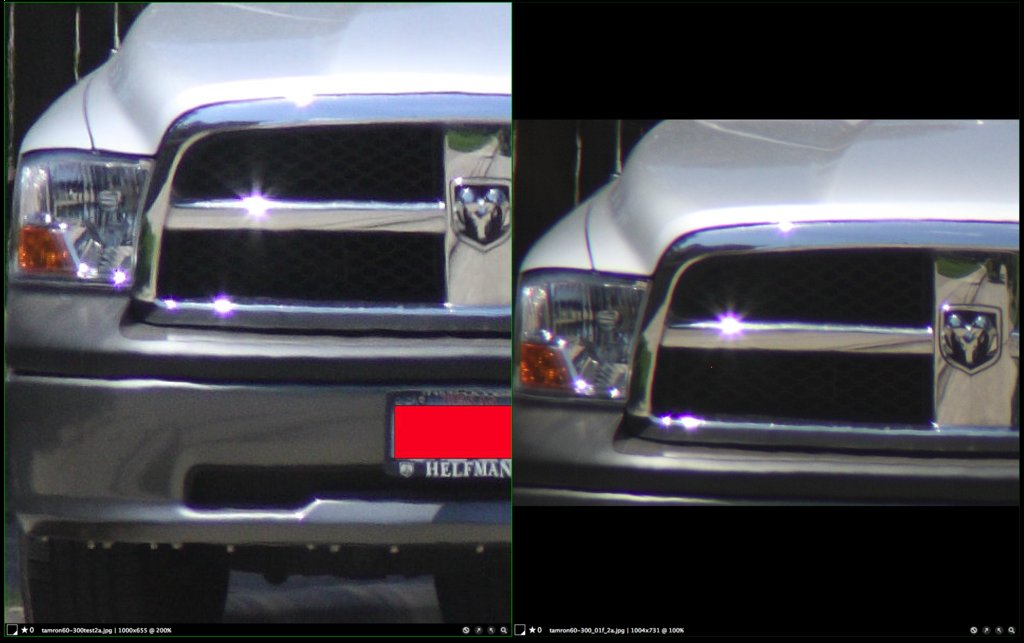
Whilst "without" reveals pixellation (obviously at 200%) there is only marginally more information in the "with" shot. Look at the reflection of the road in the centre part of the chromed trim. The basic detail is there in both shots, adding the TC adds a bit more smoothness due to the lack of pixellation and hence a bit more definition, but the amount of detail is hardly changed. Also, look at the sharpness on the edges around the light fitting. I would say it is worse with the TC.
As far as the colour fringing is concerned, I looked at the edge of the car's bonnet (hood) above the chromed trim. You can clearly see the purple line has been enlarged with the TC fitted. This is obviously going to happen. If the lens produces a colour fringe, the TC will simply expand it like it does with the rest of the image!
A further complication is the the TC loses 2 stops and thus it is not unreasonable to compare the "without" result at an indicated two stops down relative to the "with" result. Below is the "without" at true f11 compared to "with 01F TC" also at true f11. Now we see just how poor the TC really is. No contest in my opinion.
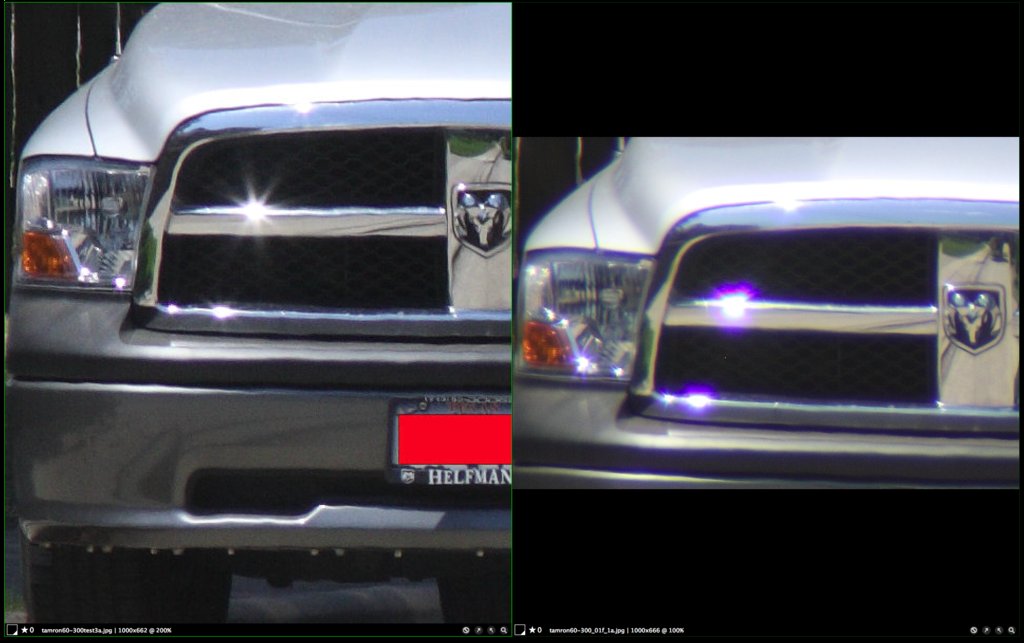
Even comparing "without" at true f11 to "with" at true f22, I do not see an advantage to using the TC (I actually prefer "without"). I would certainly want a real 600mm lens to offer a significant improvement over a cropped 300mm lens.

Your work is fully in line with my own experiences that adding the TC does not really give you that much extra and is certainly a long way short from the improvement that should be expected from doubling the FL of a lens.
Mark
_________________
Olympus OM-D E-M1 for everything |
|
| Back to top |
|
 |
SXR_Mark


Joined: 12 Jun 2010
Posts: 506
Location: England
|
 Posted: Fri May 06, 2011 12:51 pm Post subject: Posted: Fri May 06, 2011 12:51 pm Post subject: |
 |
|
SXR_Mark wrote:
| SXR_Mark wrote: |
| ....As far as the colour fringing is concerned, I looked at the edge of the car's bonnet (hood) above the chromed trim. You can clearly see the purple line has been enlarged with the TC fitted. This is obviously going to happen. If the lens produces a colour fringe, the TC will simply expand it like it does with the rest of the image!.... |
After writing this, I remembered this test of tele lenses with an without TCs. One of the lenses tested was a Tamron 300mm f2.8 (doesn't say which version) which performed quite poorly. However, the TC did act to clean up the images with the Tamron noticeably. Thus, I guess it is not strictly true to say a TC will magnify the inherent defects in a lens.
Mark
_________________
Olympus OM-D E-M1 for everything |
|
| Back to top |
|
 |
cooltouch


Joined: 15 Jan 2009
Posts: 9097
Location: Houston, Texas
|
 Posted: Fri May 06, 2011 6:04 pm Post subject: Posted: Fri May 06, 2011 6:04 pm Post subject: |
 |
|
cooltouch wrote:
| SXR_Mark wrote: |
Maybe I misunderstood the way you did the test (re: flower shots). I thought you took all the pictures from the same distance. Therefore, adding the TC doubles the magnification and should reveal twice as much detail as without it. In fact the level of detail improvement is, at best, quite maginal. |
Hey Mark,
Thanks for your thorough critique of my test. I appreciate the level of attention you've given it.
All tests were taken at the same distance. Doing otherwise would invalidate the results.
Your conclusions are in line with mine, actually. I've never argued that there should be a great deal more resolution. Just the opposite, in fact. If you read through my posts here and in the ongoing related discussion about which is the best TC, you'll see that I've always felt that TCs don't necessarily add to the resolution, bot don't detract from it.
In actual tests I've done, what I've been finding so far is that there is a slightly higher resolution with the TCs -- maybe on the order of 10% or so. And when you think about it, you really can't expect any more than this. Why? Because the TCs are attached to a lens that can only gather so much detail, and by doubling the image, this does not mean that the lens is capable of gathering twice the detail. It's not like astrophotography, where you can just leave a slow optic open longer to gather more light from faint light sources. We're dealing with daylight photography which puts a limit on the amount of information that can be gathered. Even if we weren't, and were able to leave the shutter open for a long time, I still doubt the lens would be capable of gathering more detail. And that is simply because the resolution limits of the optic can be reached with the limits we have to deal with.
The tests of the truck were meant to demonstrate if the TCs caused additional CA. They are not the best tests to use for demonstrating image detail, because there isn't a lot of fine detail in any of those images, with the possible exception of the headlights. But I wasn't focusing on the headlights -- I was focusing on the Ram medallion located in the center of the truck's grill. Also, using the SP 60-300mm at 300mm is not a good way to test for image detail either, since, while it is a nice lens, its lowest resolution occurs at 300mm. Much better to use the 90mm macro to test for resolution limits.
I can put together a test for this, if you guys are interested, and add it to this thread. Probably what I would do would be to take some printed material and locate it a certain distance away from the lens, then take pics at a range of apertures with the lens and then with the TCs.
_________________
Michael
My Gear List: http://michaelmcbroom.com/photo/gear.html
My Gallery: http://michaelmcbroom.com/gallery3/index.php/
My Flickr Page: https://www.flickr.com/photos/11308754@N08/albums
My Music: https://soundcloud.com/michaelmcbroom/albums
My Blog: http://michaelmcbroom.com/blogistan/ |
|
| Back to top |
|
 |
SXR_Mark


Joined: 12 Jun 2010
Posts: 506
Location: England
|
 Posted: Fri May 06, 2011 10:30 pm Post subject: Posted: Fri May 06, 2011 10:30 pm Post subject: |
 |
|
SXR_Mark wrote:
| cooltouch wrote: |
In actual tests I've done, what I've been finding so far is that there is a slightly higher resolution with the TCs -- maybe on the order of 10% or so. And when you think about it, you really can't expect any more than this. Why? Because the TCs are attached to a lens that can only gather so much detail, and by doubling the image, this does not mean that the lens is capable of gathering twice the detail. It's not like astrophotography, where you can just leave a slow optic open longer to gather more light from faint light sources. We're dealing with daylight photography which puts a limit on the amount of information that can be gathered. Even if we weren't, and were able to leave the shutter open for a long time, I still doubt the lens would be capable of gathering more detail. And that is simply because the resolution limits of the optic can be reached with the limits we have to deal with. |
Michael,
Please forgive me while I ramble a bit.
As far as the ultimate (ie diffraction) limited resolution goes, it is only the f# that matters. A 600mm lens at f11 will have no more resolving power than a 300mm lens at f11. Conversely, the 300mm lens at f5.6 will have a higher (better) resolving power than a 600mm lens at f 11. Thus, on that basis, adding the TC will degrade the ultimate resolution of a lens.
However, in a practical situation, the lenses will get no where near the diffraction limit so this doesn't really matter. The detail recorded in the image is a combination of two factors:
The actual resolving power of the lens (limited by aberrations and the quality of the lens elements)
The ability of the sensor to record the detail in the image formed by the lens.
If it were not for the last point, there would be no need for long focal length lenses. A good 50mm f1.4 lens will have higher resolving power (i.e. there will be more detail in the image) than a 300mm lens at f5.6 or a 600mm lens at f11. The problem is the detail of a distant subject is too closely packed to be recorded by the sensor (or film). Thus, one does use a longer focal length lens when recoding a distant subject, even though the ultimate of detail in the image is reduced. One is simply making the detail there measurable by making the image bigger.
This is why I say the TC should be able to reveal more detail in the subject. The 2x TC increases the magnification of the lens by 2x and so detail that would previously fall between the pixels in the sensor should now be resolved (measured) by the sensor. The fact that adding a 2x TC gives only a marginal increase in recorded detail indicates that it is degrading the quality of the image (blurring the detail) by almost as much as it is enlarging it. (I am assuming that the lens without TC produces more detail than the sensor can record, so that there is more detail to reveal.)
Maybe it is only a matter of viewpoint. You see the end result with the TC being a little better than without and thus conclude that it is not damaging the image. I expect the TC to give a big improvement in detail, so say it is losing information when it doesn't deliver. Your glass is half full, mine is half empty. 
Time and weather permitting, I will try and do some tests over the weekend with my test chart. Maybe I can get some more objective information on how much extra detail a TC allows to be recorded.
I would also like to compare my Zuiko 200mm f4 with 2x TC against my Zuiko 400mm f6.3 lens at f8. Why? Surely it is obvious that the 400mm lens will be better, otherwise why would people pay big money for long focal length lenses? Well maybe it is obvious (though let's wait for the results), but this will show (subjectively at least) why I say a TC loses detail. The 200mm+TC is a 400mm f8 lens. The 400mm lens at f8 is also, well, a 400mm f8 lens. In an ideal world (free of aberrations) they should perform the same. If the 200mm+TC is obviously worse, then the TC is degrading the image.
As I said at the top, this is more a set of thoughts than a particular comment on your comments (on my comments.....). I do understand what you are saying. Pragmatically, what matters is the end result. If a TC helps (improves things) than it is doing its job.
Mark
_________________
Olympus OM-D E-M1 for everything |
|
| Back to top |
|
 |
SXR_Mark


Joined: 12 Jun 2010
Posts: 506
Location: England
|
 Posted: Sun May 08, 2011 3:32 pm Post subject: Posted: Sun May 08, 2011 3:32 pm Post subject: |
 |
|
SXR_Mark wrote:
The weather was good enough today to do some tests of my own. I compared my OM Zuiko 200mm f4 lens with and without a Tokina RMC 2x TC against my OM Zuiko 400mm f6.3 lens. The questions I am seeking to answer are:
1. How does a lens with TC compare against an lens with twice the focal length?
2. How does the TC degrade the image of a lens?
3. Does a TC allow more information to be recorded when compared to cropping and interpolating the image recorded without the TC?
1. How does a lens with TC compare against an lens with twice the focal length?
First I'll present crops of the central region of my test chart taken with the Zuiko 400mm lens. The Chart was 13m from my Oly E3 camera. The camera was mounted on a very sturdy tripod and mirror lock-up with 5sec anti-shock and remote release were used. The focus was set on the area of the diagonal converging lines marked "A" just to the left of the central circular pattern. The ISO was set at 200. At all apertures, the finest lines at the edge of the circular pattern at the target centre can be resolved.

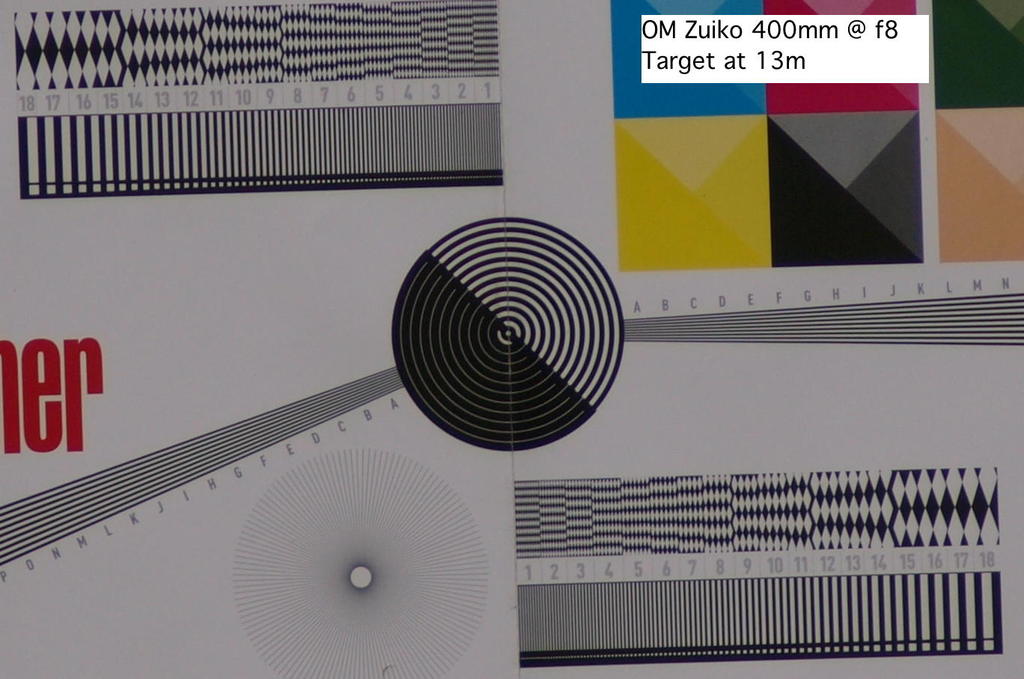
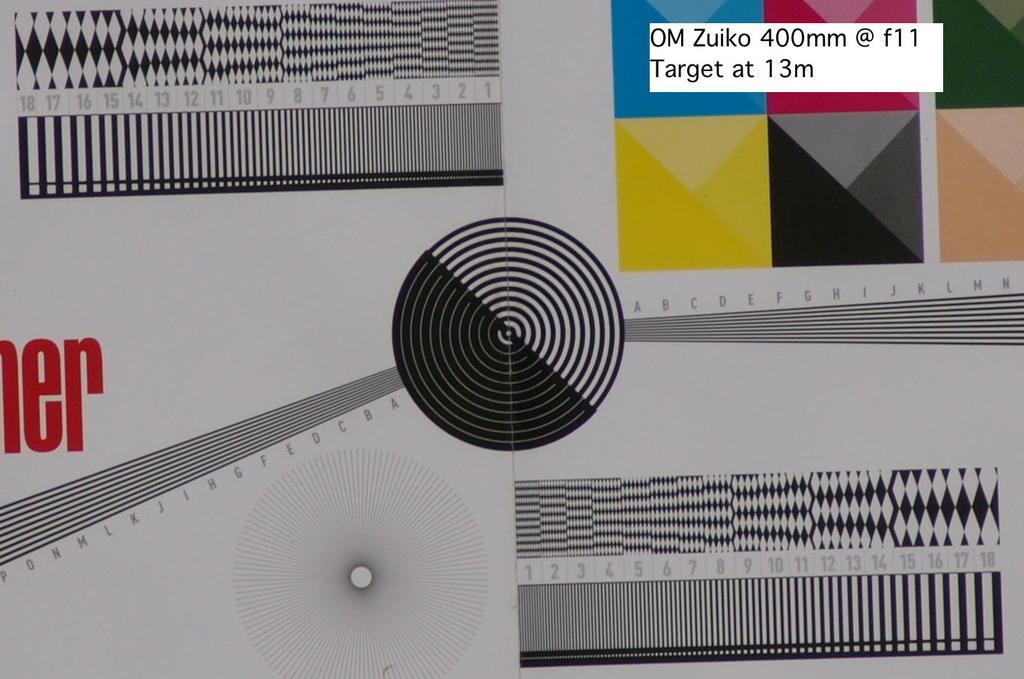
Switching to the Zuiko 200mm with TC, we have a 400mm lens with a max aperture of f8. I'll post results to f16 effective aperture.
With an effective aperture of f8 (below), the 200mm+TC is still able to resolve the lines to the circular pattern, but the contrast is much reduced by colour fringing. Resolution is not actually as good as the 400mm as can be seen from the vertical lines above the circular pattern.

At f11 equivalent, the 200mm+TC has much less fringing and the contrast is thus much better. The resolution still lags behind 400mm lens even at f6.3 though
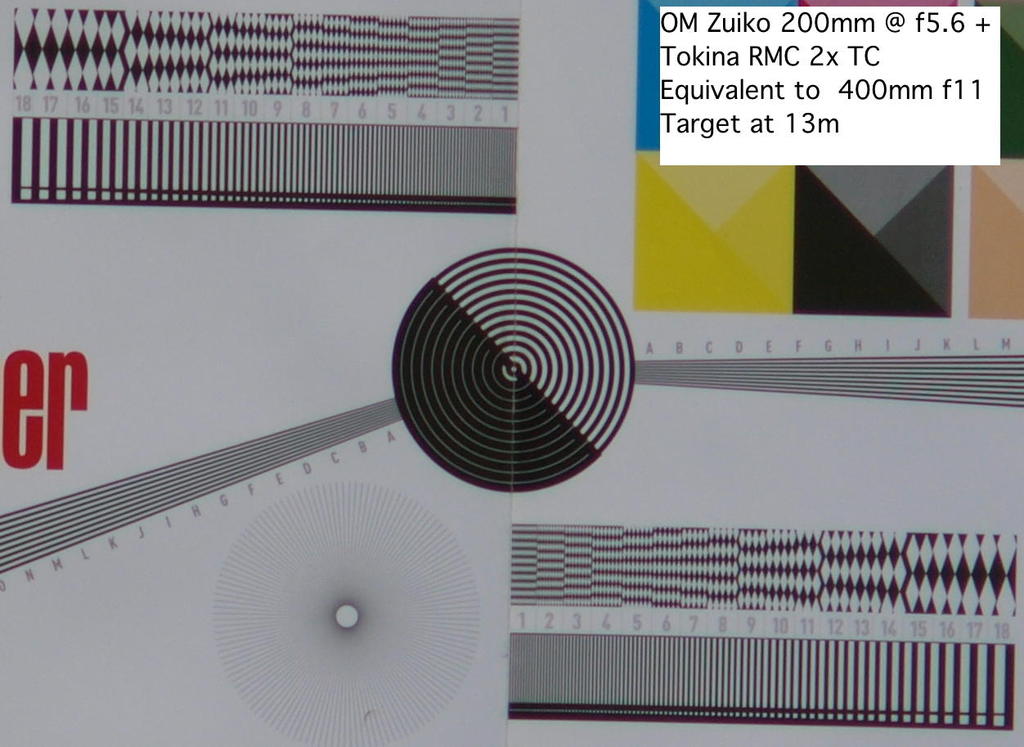
At f16 effective aperture, the 200mm + TC is just a little worse than the f11 effective aperture.

2. How does the TC degrade the image of a lens?
To test this, I compared the 200mm+TC shots against the 200mm without TC BUT with the target at half the distance from the camera. This ensures the image of the target is the same size on the sensor and so the influence of sensor sampling is negated. The main cause of any difference will be the effect of the TC (though the increased air path will have some degrading effect as well) since the performance (MTF) of the lens will hardy change over these distances.
I'll give the results with the 200mm at f4, f5.6, f8 and f11 so you can decide whether to compare at the same set apertures or the same effective apertures.
At the moment, I cannot quantify the loss from the TC since the result is heavily influenced by the loss in contrast from the significant colour fringing. But is is obvious there is some loss from the TC. With the TC at an effective aperture of f8 the "1" marks are barely resolved but are easily and cleanly resolved in the f8 shot below, or indeed the f4 shot. The Zuiko 200mm f4 is a very fine lens!
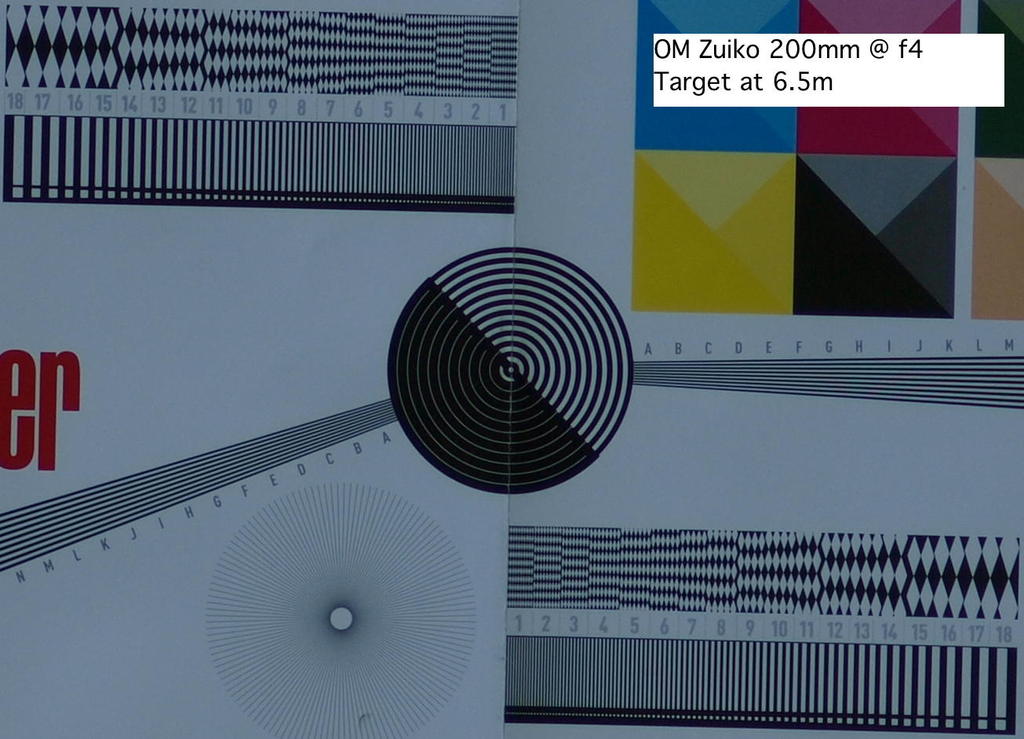
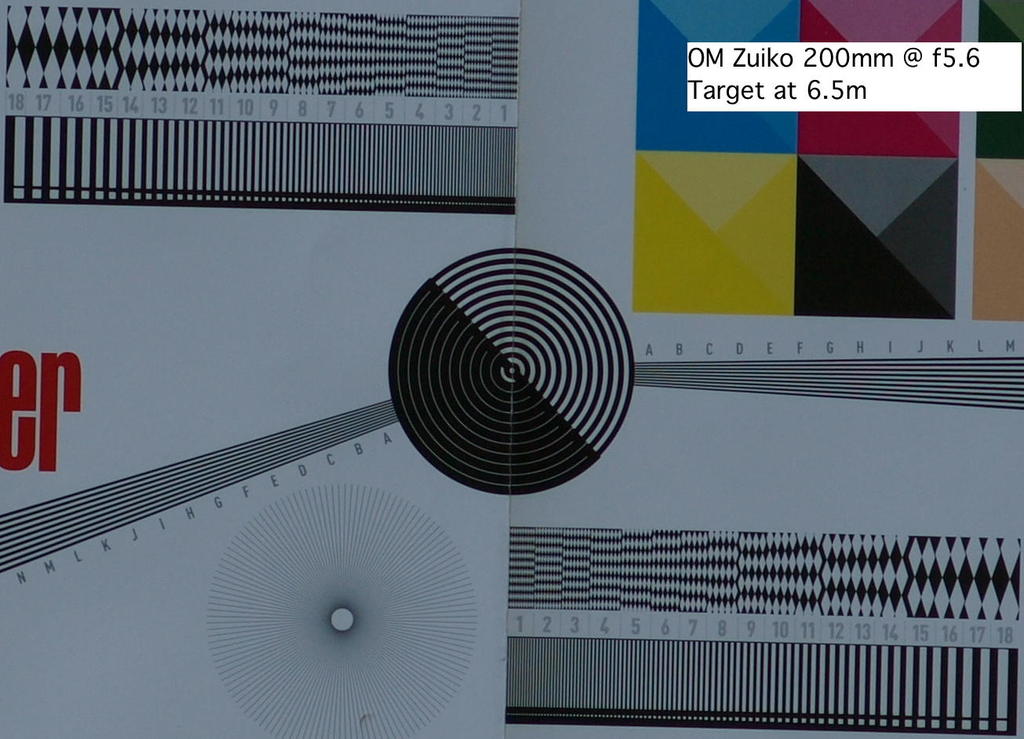
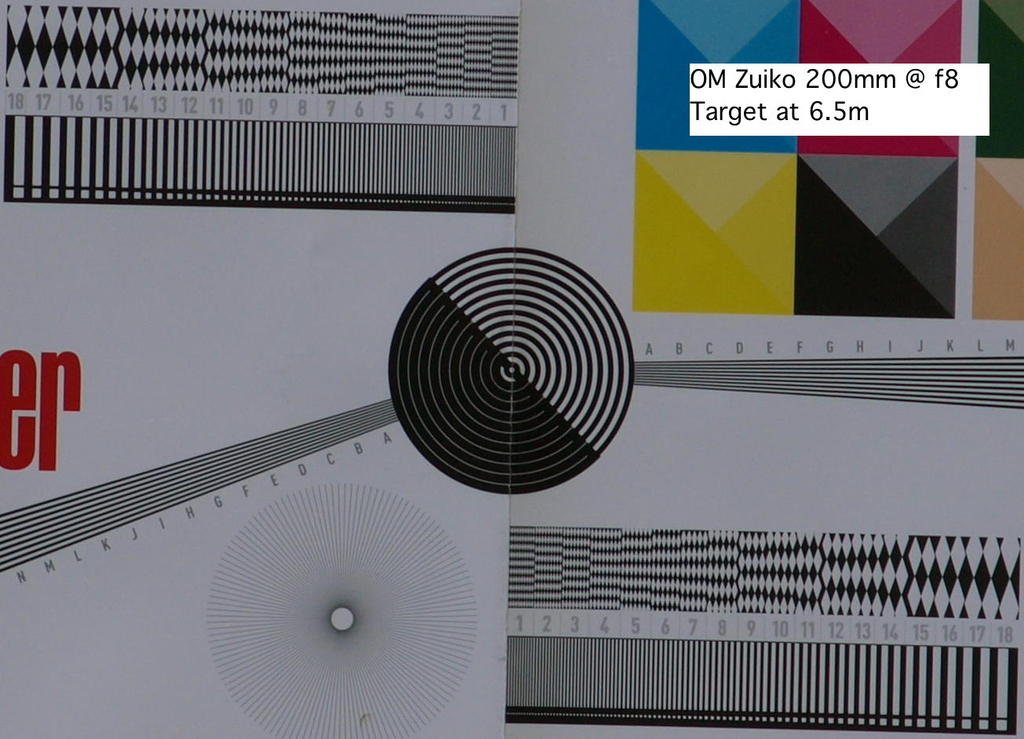

3. Does a TC allow more information to be recorded when compared to cropping and interpolating the image recorded without the TC?
To test this, I recorded the target at 13m with the 200mm lens without the TC. I've cropped the same central part of the chart and interpolated to double the number of pixels to make it comparable to the results with the TC.
Again, I'll post results at f4, f5.6, f8 and f11. It is quite clear that adding the TC allows significantly more information to be recorded than without it. Subjectively, using the results taken at f5.6 on the 200mm lens,I would say the interpolated result markings at "5" on the chart are about as well resolved as the TC result at "1". This is approximately equivalent to a doubling in resolution. But, the limit for the lens without the TC is the result of the limit of resolution of the E3 sensor, and not the lens. This demonstrates how the increased magnification provided by a TC can be beneficial.
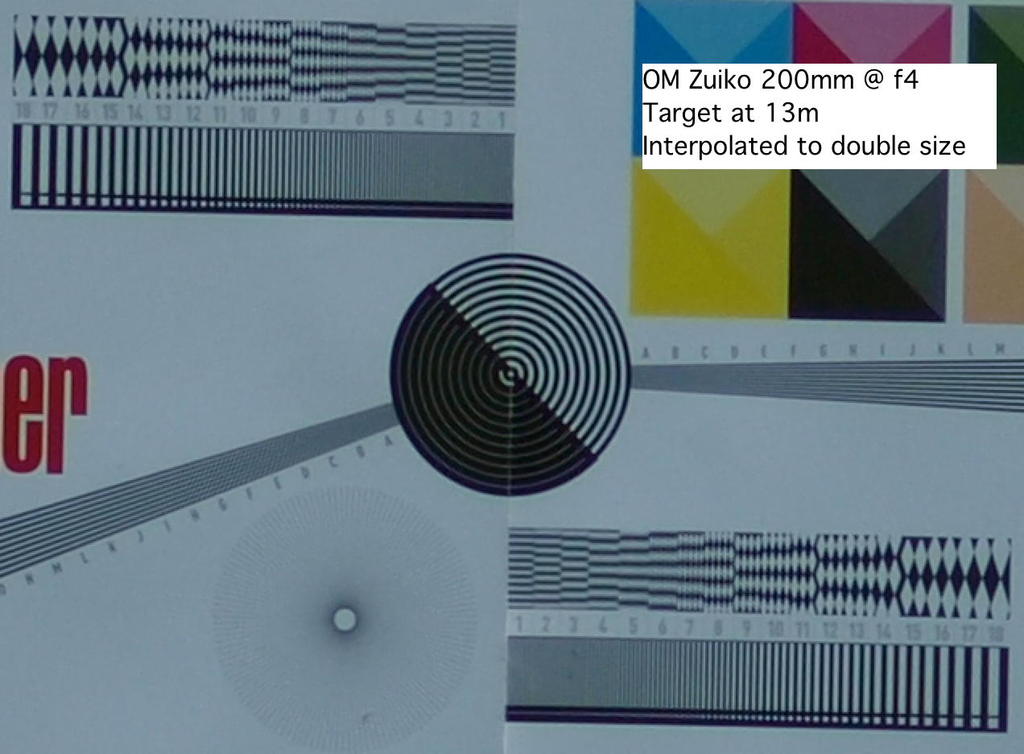
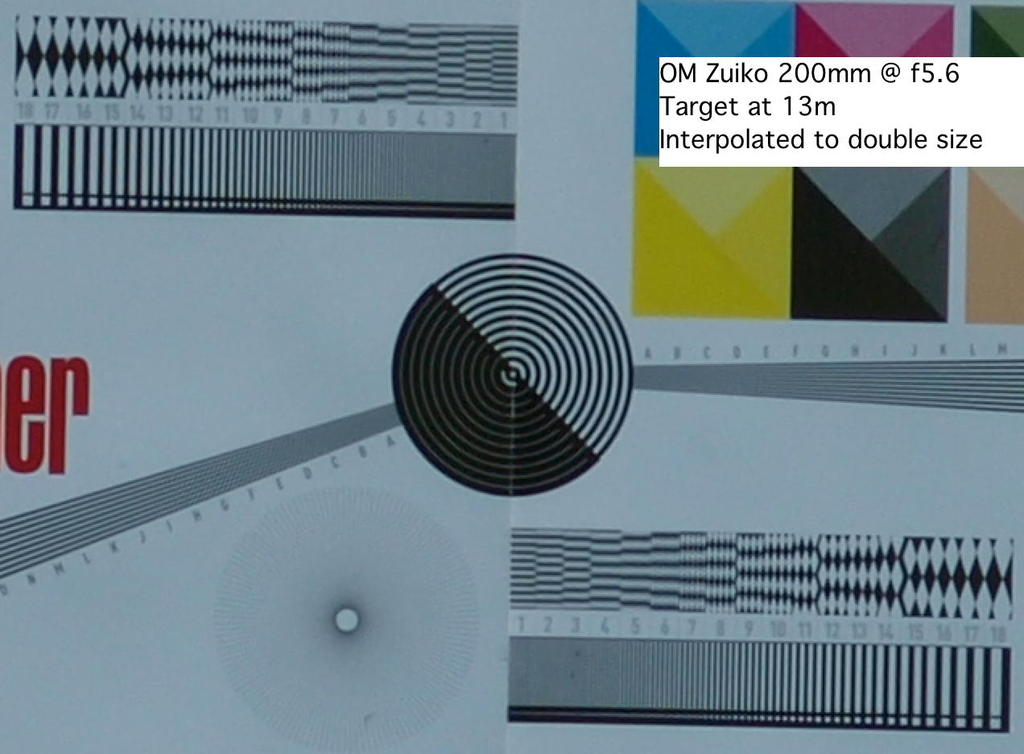
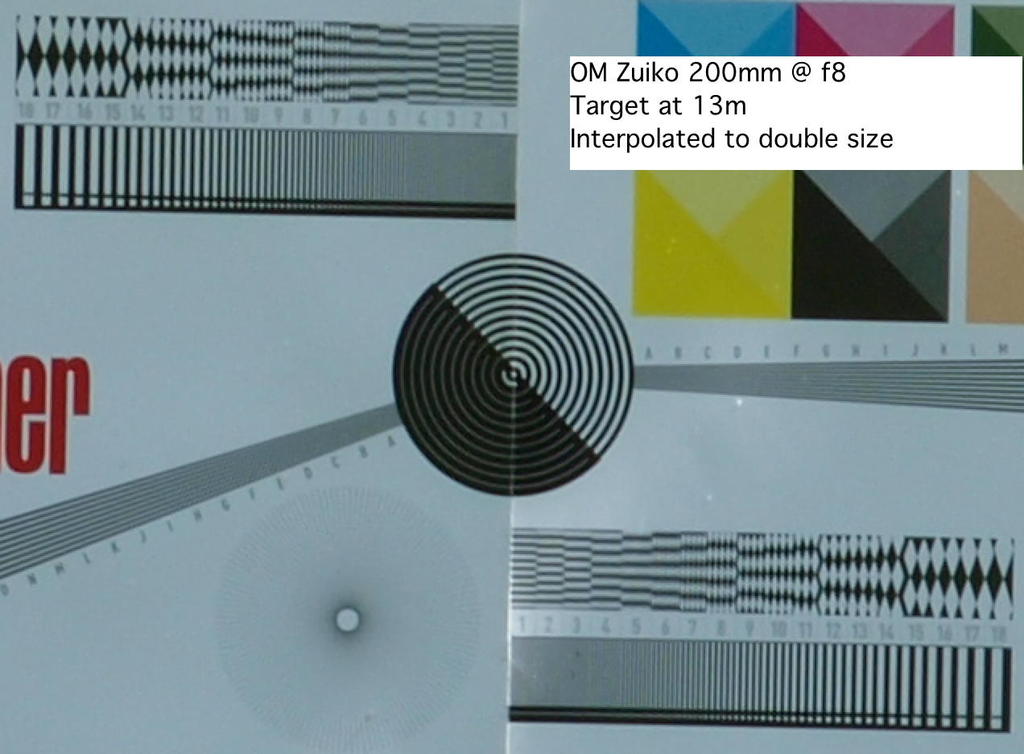
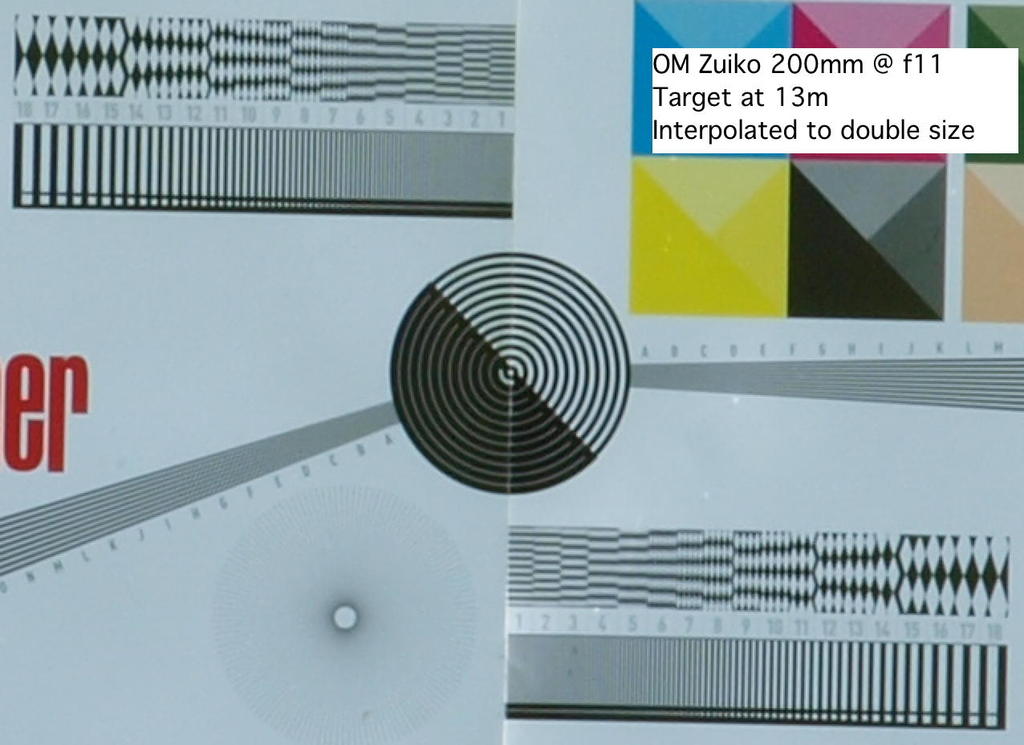
CONCLUSION
This is not a truly scientific test, so the results are indicative rather than definitive. In general I would say:
A lens with TC is in no way a substitute for a (good) dedicated lens of the same equivalent focal length. The dedicated lens will give sharper results at faster apertures.
A TC will degrade the images produced by a lens to which it is attached when compared to an image recorded without the TC but at the same image size on the sensor. The degradation is in part due to softening of detail and in part due to contrast loss through colour fringing.
A TC will give beneficial results when magnification of the lens is too low to allow the detail in the image to be recorded by the sensor.
I'll leave it to an individual to decide whether a TC is worth using of not.
Mark
_________________
Olympus OM-D E-M1 for everything |
|
| Back to top |
|
 |
cooltouch


Joined: 15 Jan 2009
Posts: 9097
Location: Houston, Texas
|
 Posted: Sun May 08, 2011 6:15 pm Post subject: Posted: Sun May 08, 2011 6:15 pm Post subject: |
 |
|
cooltouch wrote:
Well Mark, your tests are going to force me to respond with a set of my own. I will try to put together a set as rigorous as yours with the equipment I have. If only I owned a Tamron 180mm f/2.5 LD or a Nikkor 180mm f/2.8 ED, it would be easier.
My tests do not show the level of degradation caused by a TC that yours do. I would like to see your tests done with a different teleconverter that has a good reputation. I'm not saying that the Tokina RMC is not good, it's just that I don't know anything about it, whereas I know plenty about Tamron, Vivitar Macro and Nikon TCs.
So, off I go to ponder another test.
_________________
Michael
My Gear List: http://michaelmcbroom.com/photo/gear.html
My Gallery: http://michaelmcbroom.com/gallery3/index.php/
My Flickr Page: https://www.flickr.com/photos/11308754@N08/albums
My Music: https://soundcloud.com/michaelmcbroom/albums
My Blog: http://michaelmcbroom.com/blogistan/ |
|
| Back to top |
|
 |
SXR_Mark


Joined: 12 Jun 2010
Posts: 506
Location: England
|
 Posted: Mon May 09, 2011 1:13 pm Post subject: Posted: Mon May 09, 2011 1:13 pm Post subject: |
 |
|
SXR_Mark wrote:
| cooltouch wrote: |
My tests do not show the level of degradation caused by a TC that yours do.
|
Actually, the results with the TC came out better than I expected!
| cooltouch wrote: |
I would like to see your tests done with a different teleconverter that has a good reputation. I'm not saying that the Tokina RMC is not good, it's just that I don't know anything about it, whereas I know plenty about Tamron, Vivitar Macro and Nikon TCs.
|
A long time ago, I did test the Tokina against the Tamron 01F (with different lenses of course) and a couple of others. I felt the Tokina was the best because it gave less colour fringing and was at least as sharp. Since then I have acquired a Vivitar TC but have never tried it - optically it looked so similar to some of the others I've tried that there didn't seem to be any point. If I can find the time I will test the Tokina against the Vivitar.
Mark
_________________
Olympus OM-D E-M1 for everything |
|
| Back to top |
|
 |
cooltouch


Joined: 15 Jan 2009
Posts: 9097
Location: Houston, Texas
|
 Posted: Mon May 09, 2011 4:30 pm Post subject: Posted: Mon May 09, 2011 4:30 pm Post subject: |
 |
|
cooltouch wrote:
Yesterday I found several test charts and actually shot a bunch of exposures. Only to find afterward that I went about it all wrong. So I've got to reshoot everything today.
I will probably just use my Tamron 90mm macro with the two tcs. I don't have any primes of 180mm focal length. I have two 200mm primes that I can use -- one is a Canon mount, though, which would necessitate my using an FD-EOS adapter with the corrective element. I have determined to my satisfaction that it does not degrade the image as long as the aperture is about f/4 or smaller, but it does act as about a 1.2x teleconverter, which I don't need. My other 200mm prime is an old Vivitar f/3.5. I do have six different zooms that incorporate that focal length, and I'm figuring that at least a couple will be as good as, if not better than, that old Vivitar. But this means that I'll have to put all six through tests. And I don't know if I'm gonna feel like doing all that today. We'll see. So the test may wind up just being the Tamron Macro and the two telecoverters only.
It's a sunny day today so I'd better go get busy.
_________________
Michael
My Gear List: http://michaelmcbroom.com/photo/gear.html
My Gallery: http://michaelmcbroom.com/gallery3/index.php/
My Flickr Page: https://www.flickr.com/photos/11308754@N08/albums
My Music: https://soundcloud.com/michaelmcbroom/albums
My Blog: http://michaelmcbroom.com/blogistan/ |
|
| Back to top |
|
 |
cooltouch


Joined: 15 Jan 2009
Posts: 9097
Location: Houston, Texas
|
 Posted: Tue May 10, 2011 3:47 am Post subject: Posted: Tue May 10, 2011 3:47 am Post subject: |
 |
|
cooltouch wrote:
Okay, I selected a couple of the charts I found for tests. So far, I've processed only one. As it turns out, it is of rather limited usefulness, and I've only shown a small portion of the complete chart for comparison purposes. But it is somewhat illustrative at least.
Here is a shot of the complete image. At this resolution the moire patterns are going crazy. I cropped from the bottom right of this image for the comparisons. You'll note a fair amount of softness in the images. I think this is at least partially due to the fact that I'm cropping from a corner. And even though my camera has an APS-C sized sensor, it appears that it is capturing some corner softness.

This chart is supposed to show resolution in terms of lines per vertical resolution, lines per horizontal resolution, and lines per inch. Only problem is, it was printed out on a 600 dpi printer then saved to a .pdf file so the best resolution you can get from this chart is 600 dpi. And since 600 dpi translates into about 12 lp/mm, it's pretty well worthless for determining lens resolution. Still, the finest lines on the printout are able to reveal some of the resolution characteristics of the lens by itself and with the TCs.
The chart says to locate it so that the edges of the frame are just visible. So this is more or less what I did in the vertical direction. But since my viewfinder shows something less than 100% of the actual readout, it's guesswork. Still, it's no big deal, since I'm not after an accurate resolution count anyway.
One other thing bears mentioning. Each chart shows the Tamron Macro lens set to the distance where the upper and lower frames are just showing in the frame, which means it was roughly 33 inches from the sensor plane to the subject, and the two images from the TCs are roughly twice this distance. So that in itself makes for a good comparison, methinks -- showing the images from the TCs at twice the distance as the original images.
Wide open:

At f/5.6 indicated (f/11 actual with the TCs)

At f/11 indicated (f/22 actual with the TCs)

Okay, the first set of crops is pretty soft, but it appears to me that the Vivitar has a slight edge over the other two. By f/5.6 indicated, it's plainly obvious that the Tamron Macro with the Vivitar is displaying better sharpness than the other two crops. But by f/11, the Tamron without the TCs has caught back up and appears to be slightly outperforming the other two.
When I first shot this series of photos, after loading them into my computer I noticed that the ones shot with the 01F TC were really soft. So I went back and had to reshoot them all. This time they were much better, but still just a bit on the soft side.
Still, I see no dramatic difference between the lens without TCs and the lens with, except maybe at f/5.6 indicated where it appears that using the Vivitar with the Tamron macro is definitely the way to go. 
So, once again, I must respectfully disagree with Mark's analysis. As I mentioned in a previous post, it is not terribly realistic to expect much difference in the amount of detail that one can extract from an image taken with a TC and a given lens, simply because the lens is the limiting factor. For example, if a lens is shown with an optical bench test to deliver a resolving power of, say, 50 lppmm, then adding a TC to it is not going to suddenly boost the lens's resolution output to much of anything above that figure. All the TC is gonna do is double the existing image and maybe, just maybe, add a bit more detail. Mark's claim that a TC is actually doing much worse because there is essentially no improvement doesn't follow either because the TC is not anything more than a doubler. In fact, his images taken with the longer lenses tend to prove this. Which don't surprise me really. I am a bit surprised, though, that Mark's doubled, interpolated images are as soft as they are. The image doubling I have done don't lose that much detail.
Next, I'll give a shot at one of the other test targets. I just know I'm gonna have to break out all those zooms and try them out as well.
_________________
Michael
My Gear List: http://michaelmcbroom.com/photo/gear.html
My Gallery: http://michaelmcbroom.com/gallery3/index.php/
My Flickr Page: https://www.flickr.com/photos/11308754@N08/albums
My Music: https://soundcloud.com/michaelmcbroom/albums
My Blog: http://michaelmcbroom.com/blogistan/
Last edited by cooltouch on Tue May 10, 2011 3:39 pm; edited 1 time in total |
|
| Back to top |
|
 |
cooltouch


Joined: 15 Jan 2009
Posts: 9097
Location: Houston, Texas
|
 Posted: Tue May 10, 2011 4:30 am Post subject: Posted: Tue May 10, 2011 4:30 am Post subject: |
 |
|
cooltouch wrote:
This next chart, which goes by the International Standards Organization's title of ISO-12233, has everything thrown into it, including the kitchen sink. Problem is, once again, the pdf I found of it was printed at a fairly low resolution, so the finer areas of this chart are not terribly useful. Still I will attempt to soldier on. And here it is:

And once again, the low resolution I have to resort to for posting the entire image here has the moire patterns kicking up their heels again.
You'll want to check back with this post as I attempt to add things to it. It's now almost midnight and I don't know how much more of this I'll manage to get done before I'll have to head for bed. Especially since I haven't exactly figured out which parts to concentrate on. 
Oh well, I guess I have. I've chosen that heavy bar toward the bottom with a variety of line densities. This first one shows the Tamron 90mm wide open and with the TCs, also with the lens wide open. You'll note that the shots with the TCs are practically the same size as the shot without. I had to move the camera/lens combination back so they would be the same size. I used the 3:2 ratio markings in the corners to do this.

The others are much the same as the test immediately preceding this one. No noticeable departures. So, maybe I'll go looking for yet another test pattern.
_________________
Michael
My Gear List: http://michaelmcbroom.com/photo/gear.html
My Gallery: http://michaelmcbroom.com/gallery3/index.php/
My Flickr Page: https://www.flickr.com/photos/11308754@N08/albums
My Music: https://soundcloud.com/michaelmcbroom/albums
My Blog: http://michaelmcbroom.com/blogistan/
Last edited by cooltouch on Tue May 10, 2011 5:39 am; edited 2 times in total |
|
| Back to top |
|
 |
|
|
